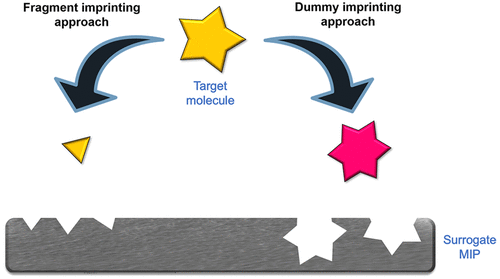当前位置:
X-MOL 学术
›
ACS Appl. Polym. Mater.
›
论文详情
Our official English website, www.x-mol.net, welcomes your
feedback! (Note: you will need to create a separate account there.)
Surrogate Imprinting Strategies: Molecular Imprints via Fragments and Dummies
ACS Applied Polymer Materials ( IF 4.4 ) Pub Date : 2020-08-05 , DOI: 10.1021/acsapm.0c00555 Beatriz Fresco-Cala 1 , Boris Mizaikoff 1
ACS Applied Polymer Materials ( IF 4.4 ) Pub Date : 2020-08-05 , DOI: 10.1021/acsapm.0c00555 Beatriz Fresco-Cala 1 , Boris Mizaikoff 1
Affiliation

|
There is an increasing need to selectively bind, determine, preconcentrate, or filter compounds frequently present at very low concentration levels in a wide variety of complex matrices. Among other strategies, this need has been addressed by MIPs serving as tailorable synthetic molecular recognition motifs. While the generation of MIPs appears synthetically straightforward, their preparation for the determination of toxic, infectious, rare, or unstable species remains a challenge due to the requirement of using the target species as the actual template during synthesis. A viable alternative is, therefore, replacing the target/template by an appropriate surrogate emulating its size, shape, and surface functionality. Functional polymer materials mimicking biological recognition processes are highly relevant and a vital research field with molecularly imprinted materials at the forefront of this development. Next to the fundamental scientific aspects related to these materials, their practical relevance is reflected in a plethora of applications ranging from biomimetic sensors and assays to selective preconcentration and filtration taking advantage of their selective recognition properties. This review aims to highlight recent advances and innovative strategies toward the development of polymers with selective recognition properties prepared via surrogate templates. Advantages and disadvantages of these strategies are discussed and contrasted by selected examples highlighting the features of such materials addressing specifically such delicate templates.
中文翻译:

替代印迹策略:通过片段和假人进行分子印迹
越来越需要选择性地结合,确定,预浓缩或过滤在各种复杂基质中经常以非常低的浓度存在的化合物。在其他策略中,通过作为可定制的合成分子识别基序的MIP解决了这一需求。虽然MIP的生成在合成上看起来很简单,但是由于需要在合成过程中将目标物种用作实际模板,因此制备用于确定有毒,传染性,稀有或不稳定物种的MIP仍然是一个挑战。因此,可行的替代方法是用适当的替代品替代目标/模板,以模拟其尺寸,形状和表面功能。模仿生物识别过程的功能性高分子材料具有高度相关性,并且是分子印迹材料在这一研究领域的前沿,是至关重要的研究领域。除了与这些材料相关的基本科学方面,它们的实用意义还反映在从仿生传感器和测定法到利用它们的选择性识别特性进行选择性预浓缩和过滤的众多应用中。这篇综述旨在重点介绍通过替代模板制备具有选择性识别特性的聚合物的最新进展和创新策略。通过选择的示例来讨论和对比这些策略的优缺点,这些示例突出了此类材料的特征,专门解决了此类精致的模板。
更新日期:2020-09-11
中文翻译:

替代印迹策略:通过片段和假人进行分子印迹
越来越需要选择性地结合,确定,预浓缩或过滤在各种复杂基质中经常以非常低的浓度存在的化合物。在其他策略中,通过作为可定制的合成分子识别基序的MIP解决了这一需求。虽然MIP的生成在合成上看起来很简单,但是由于需要在合成过程中将目标物种用作实际模板,因此制备用于确定有毒,传染性,稀有或不稳定物种的MIP仍然是一个挑战。因此,可行的替代方法是用适当的替代品替代目标/模板,以模拟其尺寸,形状和表面功能。模仿生物识别过程的功能性高分子材料具有高度相关性,并且是分子印迹材料在这一研究领域的前沿,是至关重要的研究领域。除了与这些材料相关的基本科学方面,它们的实用意义还反映在从仿生传感器和测定法到利用它们的选择性识别特性进行选择性预浓缩和过滤的众多应用中。这篇综述旨在重点介绍通过替代模板制备具有选择性识别特性的聚合物的最新进展和创新策略。通过选择的示例来讨论和对比这些策略的优缺点,这些示例突出了此类材料的特征,专门解决了此类精致的模板。











































 京公网安备 11010802027423号
京公网安备 11010802027423号